My colleague David Littell recently wrote about the inexorable shift of the US power sector toward cleaner sources of electric energy, noting that the cost of renewables has been dropping, energy efficiency continues to grow, and storage technologies have been improving, among other things. Shortly after we published his article, the US Energy Information Administration (EIA) released its Electric Power Monthly data for December 2015. With all of the 2015 data in hand, at least in preliminary form, I looked back over the decade to see if the “foundational, even tectonic shifts” that Littell described were evident. In short, they were, and to a degree that I had not imagined. Here are some of the highlights of what I found:
Efficiency First
In 2015, generation on the utility side of the meter remained essentially flat compared to recent years. Taking a long-term perspective, in the decade from 2005 to 2015 utility scale generation grew by 0.79%. Not annually. For the decade. Over the same period, real Gross Domestic Product grew by 14.41% and practically all of us added electricity-consuming gadgets to our homes and offices. The economy grew, and new technologies enriched our lives, but utility-scale electric generation remained flat. These facts alone fit the description of a tectonic shift.
Clean Keeps the Lights On
It was considered “big news” last summer when we all heard that gas-fired generation had exceeded coal-fired generation in April, for the first time in our country’s history. But this was hardly a data anomaly resulting from temporary conditions. In fact, gas-fired generation exceeded coal-fired generation in the US in every month from July to December 2015. For the entire year, coal and gas produced roughly equal shares of total generation (33% each). Again, Littell’s “inexorable shift” is even more starkly obvious if you look at the long-term trend. Coal was the primary fuel for roughly 50% of electric generation in 2005, meaning it has dropped by one-third in just one decade. Most of the difference was picked up by gas-fired generation, but non-hydro renewables also grew, from 2% of generation in 2005 to over 7% in 2015.

Emissions Decrease
Neither EIA nor the Environmental Protection Agency (EPA) has produced an official estimate of power sector emissions for 2015, but by multiplying EIA’s generation data for each fossil fuel with EIA’s average emission factors for each fuel, I calculated a rough estimate. If my estimate proves accurate, we’ll find that carbon dioxide (CO2) emissions from the power sector were about 17% lower in 2015 than in 2005. This 17% reduction would deliver the power sector’s share of the 17% economy-wide reduction target set by the Obama Administration for 2020. (It remains to be seen if other sectors, like the oil and gas sector, will achieve similar reductions. There was some worrisome news recently when EPA announced large increases in methane emissions in 2013 – something with which policymakers will have to contend.)

The “inexorable shift” to cleaner electricity is by no means in our rear view mirror. Unprecedented – probably even greater – changes still lie ahead. But I take confidence in the fact that throughout a decade of incredible uncertainty and turmoil in the electric power industry, we managed to avoid all of the “gloom and doom” predictions that sometimes arose when changes in this essential industry were contemplated. I tend to believe that the men and women in this industry are more than capable of adapting to change and offering all of us a cleaner, more reliable and resilient, and still affordable grid. With the right mix of “no regrets” state and federal policies and practices, such as cost-effective energy efficiency programs and integrated resource planning, there is every reason to believe we can continue adapting – and thriving – even in the midst of unprecedented power sector changes. And despite the current lack of clarity surrounding the Clean Power Plan, one thing is certain: power sector change is already underway.
This post originally appeared on Utility Dive. To view the original version, click here.
